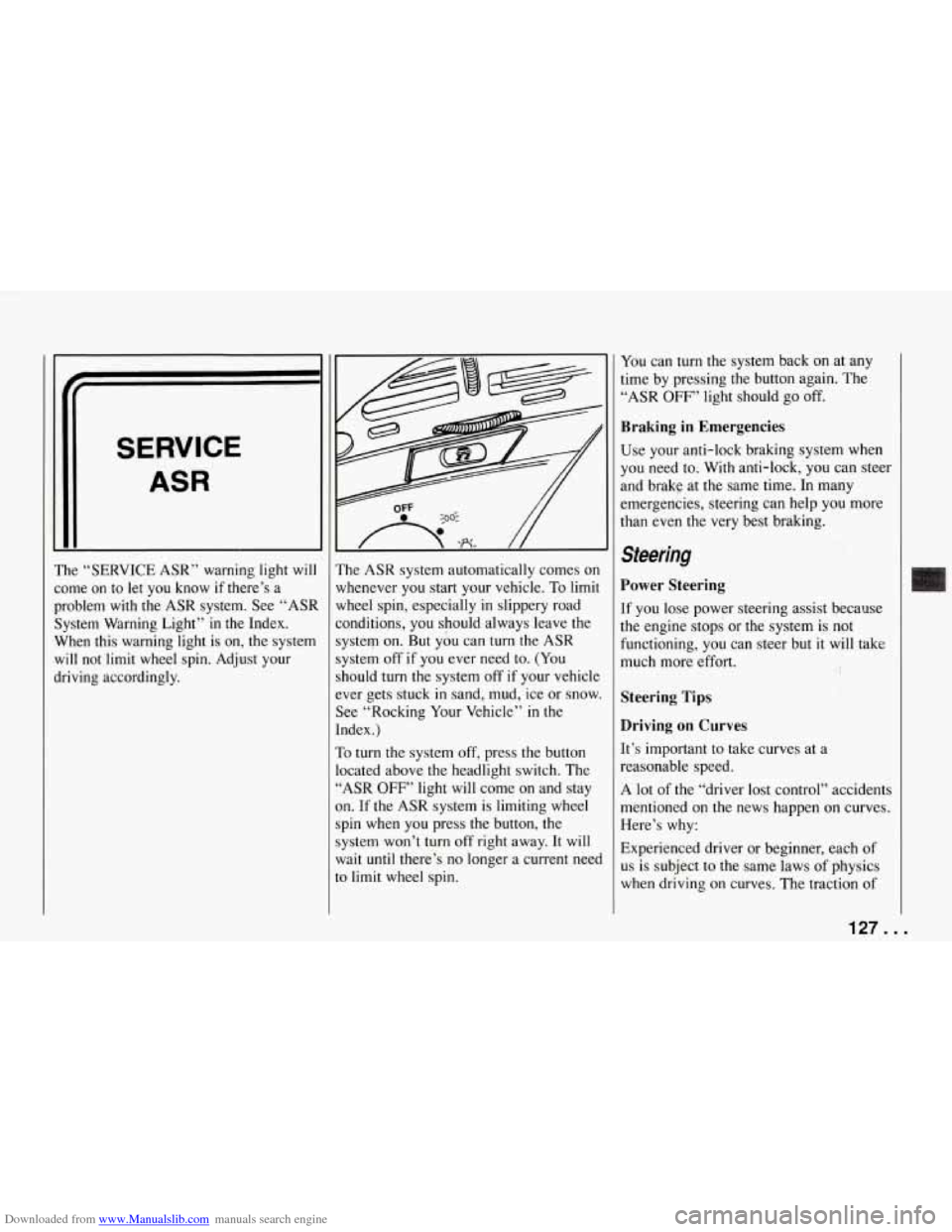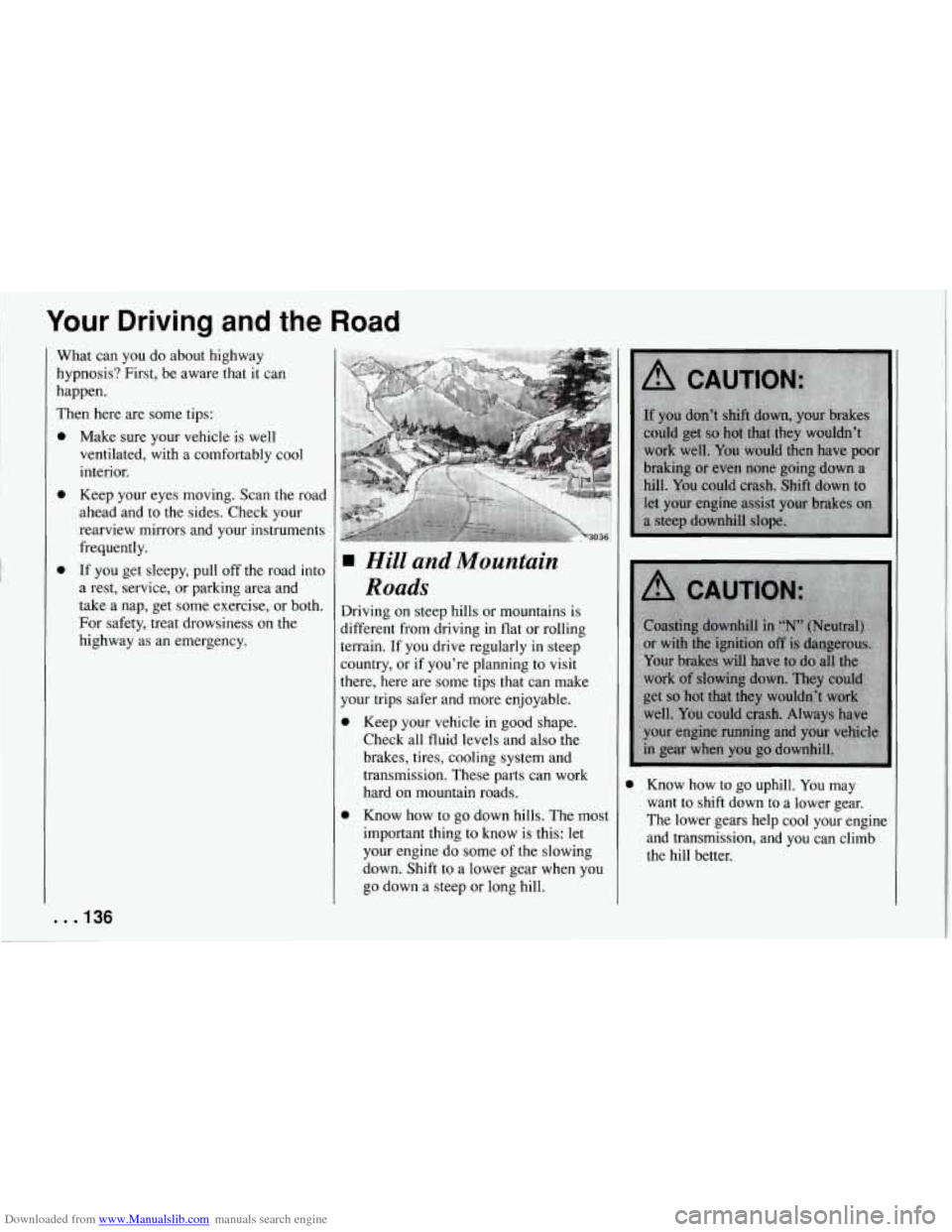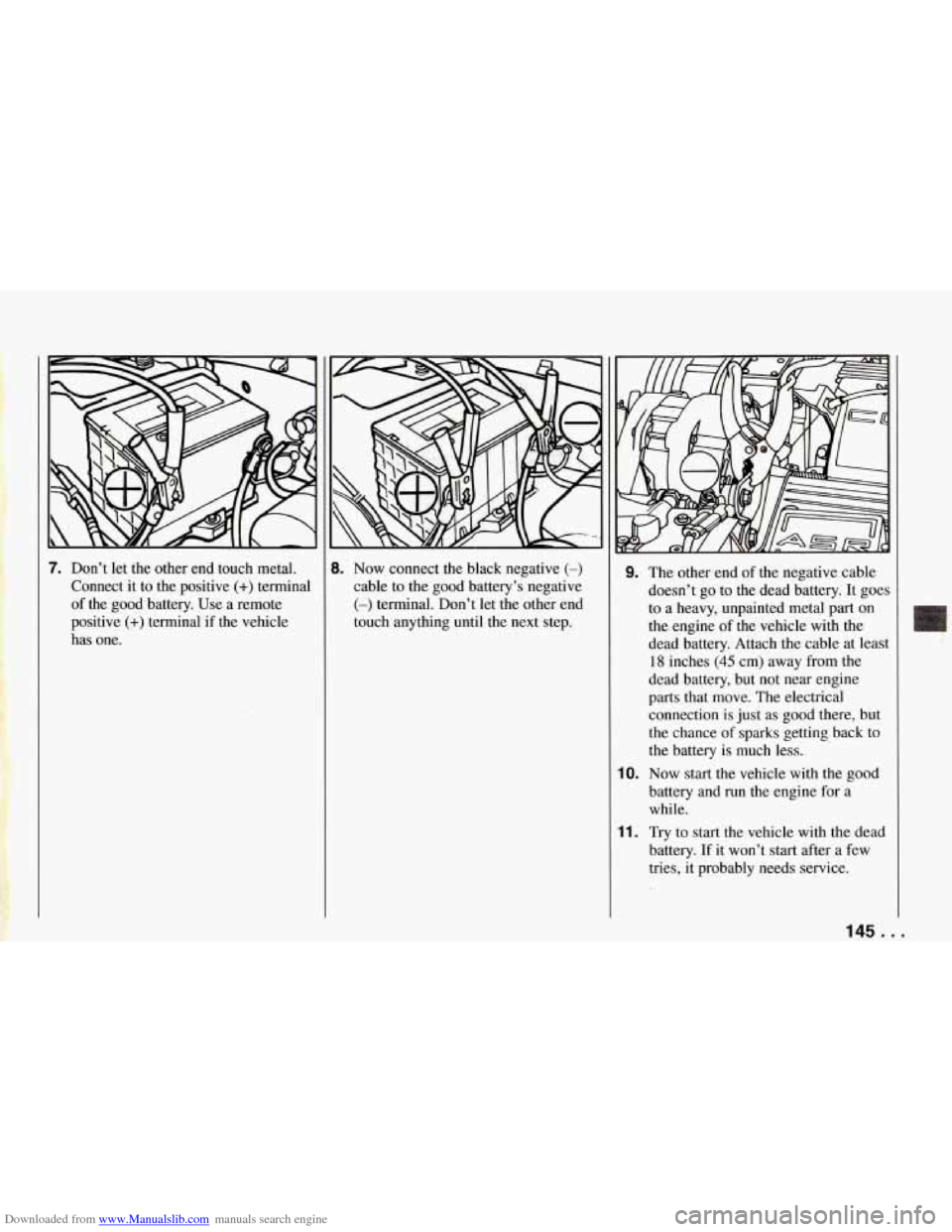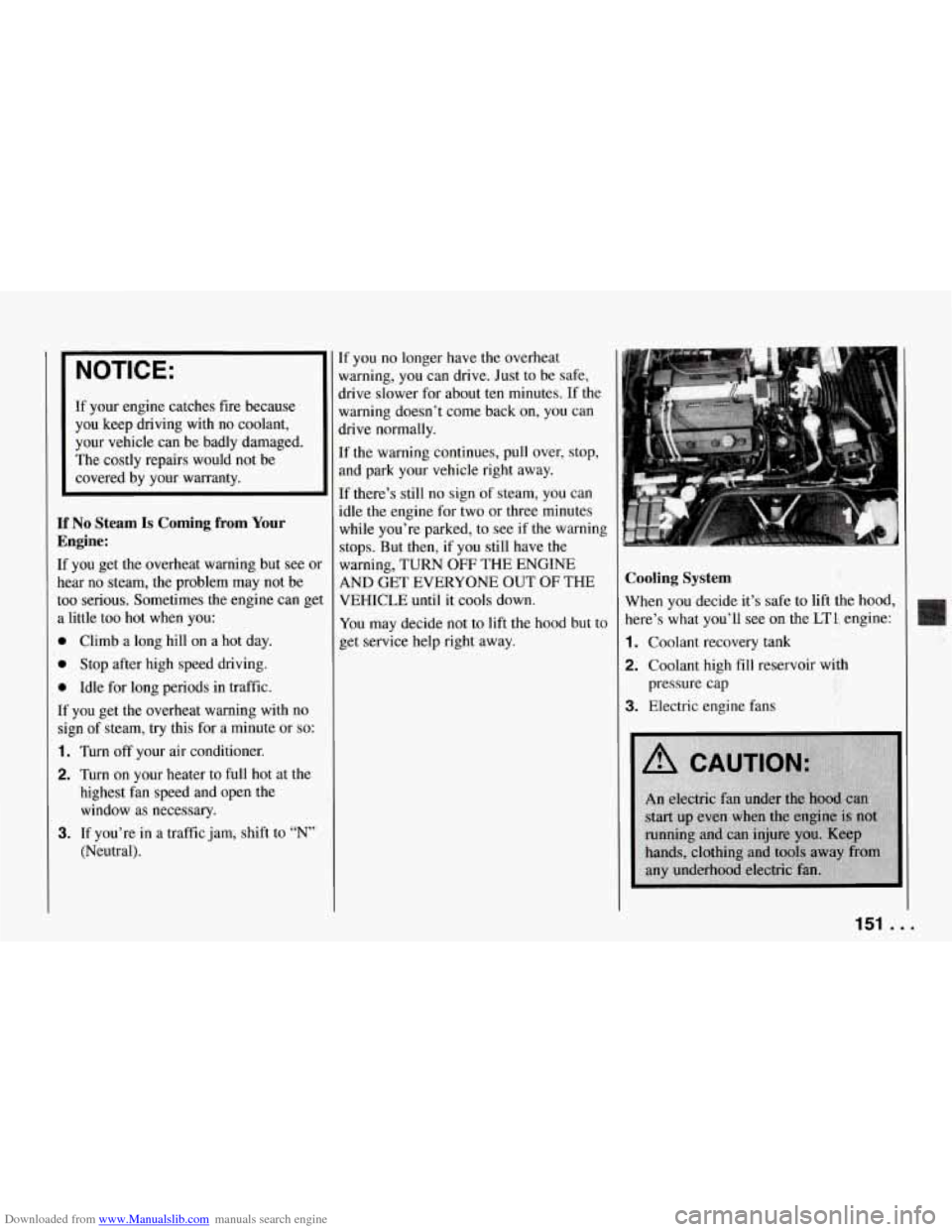1994 CHEVROLET CORVETTE service
[x] Cancel search: servicePage 128 of 274

Downloaded from www.Manualslib.com manuals search engine The
comc
prob
Whe
will
drivi Systc
SERVICE
ASR
“SERVICE ASR“ warning light will
2 on
to let you know if there’s a
lem with the ASR system. See “ASR
:m Warning Light” in the Index.
n this warning light is on, the system
not limit wheel spin. Adjust your
ng accordingly. The
ASR system automatically comes on
whenever you start your vehicle. To limit
wheel spin, especially in slippery road
conditions, you should always leave the
system on. But you can turn the ASR
system off
if you ever need to. (You
should turn the system off if your vehicle
ever gets stuck
in sand, mud, ice or snow.
See “Rocking Your Vehicle” in the
Index.)
To
turn the system off, press the button
located above the headlight switch. The
“ASR
OFF’ light will come on and stay
on. If the ASR system is limiting wheel
spin when you press the button, the
system won’t turn off right away. It will
wait until there’s no longer a current
need
to limit wheel spin.
You can turn the system back on at any
time by pressing the button again. The
“ASR
OFF’ light should go off.
Braking in Emergencies
Use your anti-lock braking system when
you need to. With anti-lock, you can steer
and brakG at the same time. In many
emergencies, steering can help you more
than even the very best braking.
Steering
; .1
,.
Power Steering
If you lose power steering assist because
the engine stops or the system is not
functioning, you can steer but it will take
much more effort.
Steering Tips
Driving on Curves
It’s important to take curves at a
reasonable speed.
A lot
of the “driver lost control” accidents
mentioned
on the news happen on curves.
Here’s why:
Experienced driver or beginner, each
of
us is subject to the same laws of physics
when driving on curves. The traction of
127 ...
Page 136 of 274

Downloaded from www.Manualslib.com manuals search engine begin to check traffic. Try to determine
where you expect to blend with the flow.
Try to merge into the gap
at close to the
prevailing speed. Switch on your turn
signal, check your mirrors and glance
over your shoulder as often as necessary.
Try to blend smoothly with the traffic
flow.
Once you are on the freeway, adjust your
speed to the posted limit or to the
prevailing rate if it’s slower. Stay in the
right lane unless you want to pass.
Before changing lanes, check your
mirrors. Then use your turn signal. Just
before you leave the lane, glance quickly
over your shoulder to make sure there
isn’t another vehicle in your “blind” spot.
Once you are moving on the freeway,
make certain you allow a reasonable
following distance. Expect to move
slightly slower at night.
When you want to leave the freeway,
move to the proper lane well
in advance.
If you miss your exit do not, under any
circumstances, stop and back up. Drive on
to the next exit.
The exit ramp can be curved, sometimes
quite sharply. The exit speed is usually
posted. Reduce your speed according to your speedometer, not
to your sense of
motion. After driving for any distance at
higher speeds, you may tend to think you
are going slower than you actually are.
Before Leaving on a Long Trip
Make sure you’re ready. Try to be well
rested. If you must start when you’re not
fresh
- such as after a day’s work -
don’t plan to ,make too many miles that
first part
of the journey. Wear comfortable
clothing and shoes you can easily drive
in.
Is your vehicle ready for a long trip? If
you keep it serviced and maintained, it’s
ready to go. If it needs service, have it
done before starting out. Of course, you’ll
find experienced and able service experts
in Chevrolet dealerships all across North
America. They’ll be ready and willing to
help if you need
it.
Here are some things you can check
before a trip:
Windshield Washer Fluid: Is the
reservoir full? Are all windows clean
inside and outside?
0 Wiper Blades: Are they in good
shape?
0
0
Fuel, Engine Oil, Other Fluids:
Have you checked all levels?
Lights: Are they all working? Are the
lenses clean?
Tires: They are vitally important to a
safe, trouble-free trip.
Is the wead
good enough for long-distance
driving? Are the tires all inflated to
the recommended pressure?
Weather Forecasts: What’s the
weather outlook along your route?
Should you delay your trip
a short
time to avoid a major storm system?
Maps: Do you have up-to-date maps?
Highway Hypnosis
Is there actually such a condition as
“highway hypnosis”? Or is it jugt plain
falling asleep at the wheel? Call it
highway hypnosis, lack of awareness, or
whatever.
There is something about an easy stretch
of road with the same scenery, along with
the hum of the tires on the road, the drone
of the engine, and the rush of the wind
against the vehicle that can make you
sleepy. Don’t let it happen to you! If it
does, your vehicle can leave the road in
less than a second, and you could crash
and be injured.
135
Page 137 of 274

Downloaded from www.Manualslib.com manuals search engine Your Driving and the Road
What can you do about highway
hypnosis? First, be aware that
it can
happen.
Then here are some tips:
0 Make sure your vehicle is well
ventilated, with a comfortably cool
interior.
0 Keep your eyes moving. Scan the road
ahead and to the sides. Check your
rearview mirrors and your instruments
frequently.
0 If you get sleepy, pull off the road into
a rest, service, or parking area and
take a nap, get some exercise, or both.
For safety, treat drowsiness on
the
highway as an emergency.
Hill and Mountain
Roads
Driving on steep hills or mountains is
jifferent from driving in flat or rolling
terrain. If you drive regularly in steep
zountry, or if you’re planning to visit there, here are some tips that can make
your trips safer and more enjoyable.
Keep your vehicle in good shape.
Check all fluid levels and also the
brakes, tires, cooling system and
transmission. These parts can work
hard on mountain roads.
Know how to go down hills. The most
important thing to know is this: let
your engine do some
of the slowing
down. Shift to a lower gear when you
go down a steep or long hill.
0 Know how to go uphill. You may
want to shift down to a lower gear.
The lower gears help cool your engine and transmission, and you can climb
the hill better.
. . .136
Page 146 of 274

Downloaded from www.Manualslib.com manuals search engine 7. Don’t let the other end touch metal.
Connect it to the positive
(+) terminal
of the good battery. Use a remote
positive
(+) terminal if the vehicle
has one.
8. Now connect the black negative (-)
cable to the good battery’s negative
(-) terminal. Don’t let the other end
touch anything until the next step.
9. The other end of the negative cable
doesn’t go to the dead battery. It goes
to a heavy, unpainted metal part on
the engine of the vehicle with the
dead battery. Attach the cable at least
18 inches (45 cm) away from the
dead battery, but not near engine
parts that move. The electrical
connection is just as good there, but
the chance of sparks getting back to
the battery is much less.
10. Now start the vehicle with the good
battery and
run the engine for a
while.
11. Try to start the vehicle with the dead
battery. If it won’t start after a few
tries, it probably needs service.
145 ...
Page 147 of 274

Downloaded from www.Manualslib.com manuals search engine Problems on the Road
I
I5 B
1
+--
12. Remove the cables in reverse order
to prevent electrical shorting. Take
care that they don’t touch each other
or any other metal.
A. Heavy Metal Engine Part
6. Good Battery
C. Dead Battery
. . .I46
WC
-
I
n
tc
U!
(t’
ta
If
rn
ac
at
th
nc
B
h;
A VI
1 Towing Your Vehicle
ry to have a GM dealer or a professional
)wing service tow your Corvette. The
sua1 towing equipmetit is a sling-type
4) or a wheel-lift (B) or car carrier (C)
)W truck.
’ your vehicle has been changed or
lodified since it was factory-new by
jding aftermarket items like fog lamps,
:ro skirting, or special tires and wheels,
Lese instructions and illustrations may
It be correct.
efore you do anything, turn on the
3zard warning flashers. When you call, tell the towing service:
0
0
0
0
0
That your vehicle cannot be towed
from the rear with sling-type
equipment.
That your vehicle has rear-wheel
drive.
The make, model, and year
of your
vehicle.
Whether you can still move the shift lever.
If there was an accident, what was
damaged.
When the towing service arrives, let
the tow operator know that this manual
contains detailed towing instructions and
illustrations. The operator may want to
see them.
Page 148 of 274

Downloaded from www.Manualslib.com manuals search engine IC
When your vehicle is being towed, have
he ignition key
off. The steering wheel
should be clamped in a straight-ahead
position, with a clamping device designed
For towing service.
Do not use the
vehicle’s steering column lock for this.
The transmission should be in “Neutral”
and the parking brake released.
Don’t have your vehicle towed
on the
rear wheels unless you must. If the
vehicle must be towed on the rear wheels,
don’t go more than
35 mph (55 kmh) or
farther than
50 miles (80 km) or your
transmission will be damaged.
Go slow
mer rough ground, and position one
wheel at a time (angled
45”) if you have
to go over curbs and rises. Wheels at the
lifted end should be at least four inches
(1 00 mm) above the ground. If these
limits must be exceeded, then the rear
wheels have to be supported
on a dolly.
14f ...
Page 152 of 274

Downloaded from www.Manualslib.com manuals search engine NOTICE:
If your engine catches fire because
you keep driving with no coolant,
your vehicle can be badly damaged.
The costly repairs would not be covered by your warranty.
If No Steam Is Coming from Your
Engine:
If you get the overheat warning but see 01
hear no steam, the problem may not be
too serious. Sometimes the engine can ge
a little too hot when you:
0 Climb a long hill on a hot day.
0 Stop after high speed driving.
0 Idle for long periods in traffic.
If you get the overheat warning with no
sign of steam,
try this for a minute or so:
1. Turn off your air conditioner.
2. Turn on your heater to full hot at the
highest fan speed and open the
window as necessary.
(Neutral).
3. If you’re in a traffic jam, shift to “N’
[f you no longer have the overheat
warning, you can drive. Just to be safe,
hive slower for about ten minutes. If the
warning doesn’t come back on, you can
drive normally.
[f the warning continues, pull over, stop,
and park your vehicle right away.
[f there’s still no sign of steam, you can
idle the engine for two or three minutes
while you’re parked, to see if the warning
stops. But then, if you still have
the
warning, TURN OFF THE ENGINE
AND GET EVERYONE OUT
OF THE
VEHICLE until it cools down.
You may decide not to lift the hood but to
get service help right away.
Cooling System
When you decide it’s safe to lift the hood,
here’s what you’ll see on the LTl engine:
1. Coolant recovery tank
2. Coolant high fill reservoir with
3. Electric engine fans
pressure cap
151 ...
Page 153 of 274

Downloaded from www.Manualslib.com manuals search engine Problems on the Road
F
Cooling System
When you decide it’s safe to lift the hood,
here’s what you’ll see on the
LT5 engine:
1. Coolant recovery tank
2. Coolant high fill reservoir with
3. Electric engine fans
pressure cap
. . -152
If
the coolant inside the coolant recovery
tank is boiling, don’t do anything else
until it cools down.
When it is cool, remove the coolant
recovery tank cap and look at the dipstick.
The coolant level should be at or above
“COLD.” If it isn’t, you may have a leak
in the radiator hoses, heater hoses,
radiator, water pump or somewhere else
in the cooling system.
I NOTICE:
I
Engine damage from running your
engine without coolant isn’t covered
by your warranty.
If there seems to be no leak, check
to see
if the electric engine fans are running.
If the engine is overheating, both fans
should be running.
If they aren’t, your
vehicle needs service.